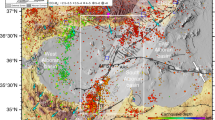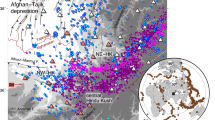Abstract
The subduction of large topographic features such as seamounts has been linked to plate locking1,2,3,4,5,6,7, earthquake generation8 and segmentation6, as well as crustal erosion9,10,11 at subduction zones. However, the role of subducted features in the generation of megathrust earthquakes has been difficult to discern because traditional imaging techniques are limited to the upper 12 km of the Earth’s crust12, whereas these ruptures initiate at depths of 20–40 km (ref. 13). Here we use a deeply penetrating imaging technique with a low-energy source to identify a seamount 3–4 km high and 40 km wide that has been subducted to a depth of 30–40 km below the Sumatra forearc mantle. We find that the seamount has remained intact despite more than 160 km of subduction, and that there is no seismic activity either above or below the seamount. We therefore conclude that the coupling between the seamount and overriding plate is weak and aseismic14. We suggest that the subduction of a topographic feature such as a seamount could lead to the segmentation of the subduction zone, which could in turn reduce the maximum size of megathrust earthquakes in these localities.
This is a preview of subscription content, access via your institution
Access options
Subscribe to this journal
Receive 12 print issues and online access
$259.00 per year
only $21.58 per issue
Buy this article
- Purchase on Springer Link
- Instant access to full article PDF
Prices may be subject to local taxes which are calculated during checkout




Similar content being viewed by others
References
Cloos, M. Thrust type subduction zone earthquakes and seamount asperities: A physical model for earthquake rupture. Geology 20, 601–604 (1992).
Scholz, C. H. & Small, C. The effect of seamount subduction on seismic coupling. Geology 25, 487–490 (1997).
Kodaira, S., Takahashi, N., Nakanishi, A., Miura, S. & Kaneda, Y. Subducted seamount imaged in the rupture zone of the 1946 Nankaido earthquake. Science 289, 104–106 (2000).
Bilek, S. L., Schwartz, S. Y. & DeShon, H. R. Control of seafloor roughness on earthquake rupture behaviour. Geology 31, 455–458 (2003).
Robinson, D. P., Das, S. & Watts, A. B. Earthquake rupture stalled by subducting fracture zone. Science 312, 1203–1205 (2006).
Cummins, P. R., Baba, T., Kodaira, S. & Kaneda, Y. The 1946 Nankai earthquake and segmentation of the Nankai Trough. Phys. Earth Planet. Int. 132, 75–87 (2002).
Mochizuki, K., Yamada, T., Shinohara, M., Yamanaka, Y. & Kanazawa, T. Weak interplate coupling by seamounts and repeating M∼7 earthquakes. Science 321, 1194–1197 (2008).
Abercrombie, R. E., Antolik, M. & Ekström, G. The June 2000 Mw 7.9 earthquake south of Sumatra: Deformation in the India–Australia Plate. J. Geophys. Res. 108, 2018 (2003).
Ranero, C.R. & van Huene, R. Subduction erosion along the Middle America convergent margin. Nature 404, 748–752 (2000).
Bangs, N. L. B., Gulick, S. P. S. & Shipley, T. H. Seamount subduction erosion in the Nankai Trough and its potential impact on the seismogenic zone. Geology 34, 701–704 (2006).
von Huene, R., Ranero, C. R. & Vannucchi, P. Generic model of subduction erosion. Geology 32, 913–916 (2004).
von Huene, R. When seamounts subduct. Science 321, 1165–1166 (2008).
Das, S. & Scholz, C. H. Why large earthquakes do not nucleate at shallow depth. Nature 305, 621–623 (1983).
Chlieh, M., Avouac, J-P., Sieh, K., Natawidjaja, D. H. & Galetzka, J. Investigation of interseismic strain accumulation along the Sunda megathrust, offshore Sumatra. J. Geophys. Res. 113, B05305 (2008).
Konca, A. O. et al. Partial rupture of a locked patch of the Sumatra megathrust during the 2007 earthquake sequence. Nature 456, 631–635 (2008).
Fitch, T. J. Plate convergence, transcurrent faults, and internal deformation adjacent to Southeast Asia and the western Pacific. J. Geophys. Res. 77, 4432–4462 (1972).
Prawirodirdjo, L., McCaffrey, R., Chadwell, C. D., Bock, Y. & Subarya, C. Geodetic observation of an earthquake cycle at the Sumatra subduction zone: Role of interseismic strain segmentation. J. Geophys. Res. 115, B03414 (2010).
Kopp, H., Flueh, E., Klaeschen, D., Bialas, J. & Reichert, C. Crustal structure of the central Sunda margin at the onset of oblique subduction. Geophys. J. Int. 147, 449–474 (2001).
Singh, S. C. et al. Evidence of active backthrusting at the NE Margin of Mentawai Islands, SW Sumatra. Geophys. J. Int. 180, 703–714 (2010).
Chauhan, A. et al. Seismic imaging of forearc backthrusts at northern Sumatra subduction zone. Geophys. J. Int. 179, 1772–1780 (2009).
Singh, S. C. et al. Seismic evidence for broken oceanic crust in the 2004 Sumatra earthquake epicentral region. Nature Geosci. 1, 777–781 (2008).
Dessa, J-X. et al. Megathrust earthquakes can nucleate in the forearc mantle: Evidence from the 2004 Sumatra event. Geology 37, 659–662 (2009).
Simoes, M., Avouac, J. P., Cattin, R. & Henry, P. Sumatra subduction zone: A case for a locked fault zone extending into the mantle. J. Geophys. Res. 109, B10402 (2004).
Schöffel, H-J. & Das, S. Fine details of the Wadati–Benioff zone under Indonesia and its geodynamic implications. J. Geophys. Res. 104, 13101–13114 (1999).
Dominguez, S., Malavieille, J. & Lallemand, S. E. Deformation of accretionary wedges in response to seamount subduction: Insights from sandbox experiments. Tectonics 19, 182–196 (2000).
Sclater, J. G. & Christie, P. A. F. Continental stretching: An explanation of the post—mid-Cretaceous subsidence of the Central North Sea basin. J. Geophys. Res. 85, 3711–3739 (1980).
Diament, M. et al. Mentawai fault zone off Sumatra—a new key to the geodynamics of western Indonesia. Geology 20, 259–262 (1992).
Cande, S. C. & Kent, D. V. Revised calibration of the geomagnetic polarity time scale for the late Cretaceous and Cenozoic. J. Geophys. Res. 100, 6093–6095 (1995).
Dewey, J. W. Seismic Studies with the Method of Joint Hypocenter Determination, PhD Thesis, Univ. of California, Berkeley (1971).
Acknowledgements
We would like to thank the Chairman and CEO of CGGVeritas for supporting and funding the project. The Oxford group was partially supported by the UK Natural Environment Research Council grant NE/D004381/1. Institut de Physique du Globe contribution number 3131.
Author information
Authors and Affiliations
Contributions
S.C.S. led the project and wrote the paper. N.H. participated in the experiment and in writing the paper. M.M. and S.D. participated in writing the paper. D.P.R. relocated the earthquakes and participated in writing the paper. A.C., H.C., B.G. and Y.D. participated in the experiment. S.M. helped in designing the experiment. H.H. was instrumental in obtaining permits to acquire the data.
Corresponding author
Ethics declarations
Competing interests
The authors declare no competing financial interests.
Supplementary information
Supplementary Information
Supplementary Information (PDF 1943 kb)
Rights and permissions
About this article
Cite this article
Singh, S., Hananto, N., Mukti, M. et al. Aseismic zone and earthquake segmentation associated with a deep subducted seamount in Sumatra. Nature Geosci 4, 308–311 (2011). https://doi.org/10.1038/ngeo1119
Received:
Accepted:
Published:
Issue Date:
DOI: https://doi.org/10.1038/ngeo1119
This article is cited by
-
Tsunami tide prediction in shallow water using recurrent neural networks: model implementation in the Indonesia Tsunami Early Warning System
Journal of Reliable Intelligent Environments (2023)
-
Evolution of the geological structure and mechanical properties due to the collision of multiple basement topographic highs in a forearc accretionary wedge: insights from numerical simulations
Progress in Earth and Planetary Science (2022)
-
Stress, rigidity and sediment strength control megathrust earthquake and tsunami dynamics
Nature Geoscience (2022)
-
Complex tsunami hazards in eastern Indonesia from seismic and non-seismic sources: Deterministic modelling based on historical and modern data
Geoscience Letters (2021)
-
Fluid-rich subducting topography generates anomalous forearc porosity
Nature (2021)



